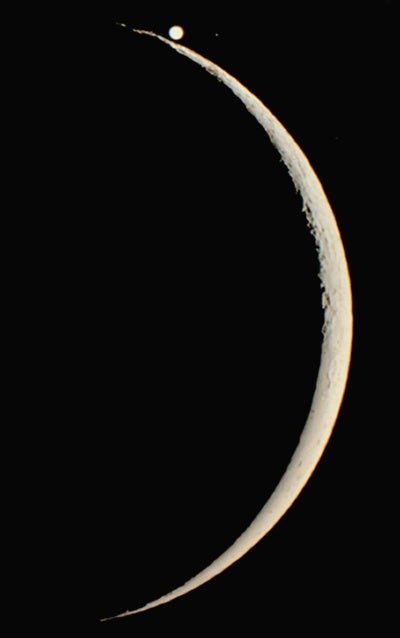Have you ever played peek-a-boo with an infant? As your face magically disappears and reappears from behind a curtain, the child squeals with delight. On Tuesday, many early-morning skywatchers may have the same reaction as they play the game with the Moon and Jupiter.
Observers in most of eastern and central North America will have an opportunity to see this naked-eye event. Facing southeast, you will spot the duo about one-third of the way up in the sky. Most will see a total occultation, but observers along different areas of the Moon’s path will see our satellite occult different parts of Jupiter and its Galilean moons.
Although the lunar occultation will dazzle naked-eye observers, this sky event will provide an added bonus for those using telescopes. Watch for the reappearance of two of the four Galilean moons before Jupiter passes from behind the Moon. Callisto and Ganymede will be visible roughly 5 to 15 minutes before their parent planet. After Jupiter reappears, Europa will show up a couple of minutes afterward. Jupiter will temporarily block Io, the final satellite of this quartet. Io will join the others shortly thereafter. Even if you’re using a small telescope, that’s two occultations for the price of one!
Read the chart below to find the best times to view Jupiter’s disappearing and reappearing act.
| Jupiter occultation — December 7 | ||
|---|---|---|
| city | disappearance | reappearance |
| Atlanta | 3:55 a.m. EST | 4:53 a.m. EST |
| Boston | 3:59 a.m. EST | 5:08 a.m. EST |
| Chicago | 2:50 a.m. CST | 3:54 a.m. CST |
| Dallas | 2:56 a.m. CST | 3:37 a.m. CST |
| Houston | 3:06 a.m. CST | 3:29 a.m. CST |
| Kansas City | 2:49 a.m. CST | 3:48 a.m. CST |
| Miami | 4:15 a.m. EST | 4:46 a.m. EST |
| Nashville | 2:52 a.m. CST | 3:52 a.m. CST |
| Pittsburgh | 3:53 a.m. EST | 5:00 a.m. EST |
| Washington, D.C. | 3:54 a.m. EST | 5:03 a.m. EST |










